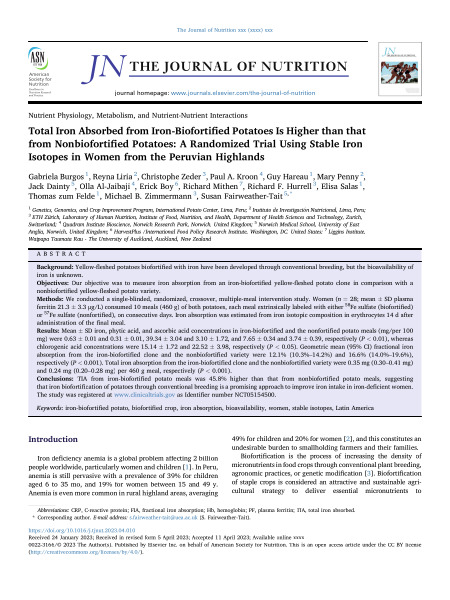Total iron absorbed from iron-biofortified potatoes is higher than from non-biofortified potatoes: a randomized trial using stable iron isotopes in women from the Peruvian highlands
Abstract
Background
Yellow fleshed potatoes biofortified with iron have been developed through conventional breeding but the bioavailability of the iron is unknown.
Objectives
Our objective was to measure iron absorption from an iron-biofortified yellow fleshed potato clone in comparison with a non-biofortified yellow fleshed potato variety.
Methods
We conducted a single-blinded, randomized, crossover, multiple-meal intervention study. Women (n = 28; mean±SD plasma ferritin 21.3±3.3 μg/L) consumed 10 meals (460 g) of both potatoes, each meal extrinsically labelled with either 58Fe sulfate (biofortified) or 57Fe sulfate (non-fortified) , on consecutive days. Iron absorption was estimated from the iron isotopic composition in erythrocytes 14 days after administration of the final meal.
Results
Mean±SD iron, phytic acid and ascorbic acid concentrations in the the iron-biofortified and the non-fortified potato meals (mg/per 100 mg) were 0.63±0.01 and 0.31±0.01 , 39.34±3.04 and 3.10±1.72 , and 7.65±0.34 and 3.74±0.39 , respectively (P < 0.01) while chlorogenic acid concentrations were 15.14±1.72 and 22.52±3.98 , respectively (P <0.05). Geometric mean (95% CI) fractional iron absorption (FIA) from the iron-biofortified clone and the non-biofortified variety was 12.1% (10.3-14.2%) and 16.6% (14.0-19.6%), respectively (P <0.001). Total iron absorption (TIA) from the iron-biofortified clone and the non-biofortified variety was 0.35 mg (0.30–0.41mg) and 0.24 mg (0.20–0.28 mg) per 460 g meal, respectively (P <0.001).
Conclusions
TIA from the iron-biofortified potato meals was 45.8% higher than from the non-biofortified potato meals, suggesting iron biofortification of potatoes through conventional breeding is a promising approach to improve iron intakes in iron-deficient women (p<0.01).

